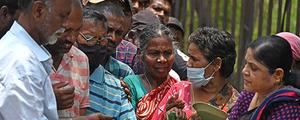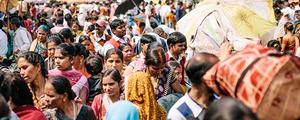Story Highlights
- Young people in India see brighter future, job prospects
- 85% of Indians believe children have opportunity to learn and grow
- Satisfaction with education reached 83% in 2022
This is the first article in a three-part series on the opportunities and challenges facing India, which recently overtook China as the most populous country in the world.
WASHINGTON, D.C. -- Worldwide, one in five people under the age of 25 live in India, and this age group accounts for nearly half of the country’s burgeoning population.
As the world’s newly minted most populous country forges its path into the rest of the 21st century, Gallup data show Indians in this demographic dividend are more hopeful for the future than they have been in most years since 2009, and more hopeful than older generations.
Quick Summary: After India gained its independence in August 1947, its population grew rapidly -- almost trebling during nearly six decades. In the 1950s, the average Indian woman gave birth to over six children. India’s population grew by about 2% annually for much of the second half of the 20th century, giving rise to concerns about the repercussions of such rapid population growth.
These concerns are no longer seen as realistic. India’s fertility rate has fallen in recent years, with women now having an average of two children. Deaths have declined as life expectancy has risen, boosted by rising incomes and better access to healthcare and education. The population is expected to start slowly declining by the 2060s.
Today, Indians under 25 make up nearly half (47%) of the nation’s population. They will be a driving force in India’s economic development for decades to come.
India Getting Better for Children: In recent years, more Indians have come to see their country as a good place for children -- of which there are around 445 million today. In 2022, 85% felt that children have the chance to learn and grow every day, an increase of 28 percentage points from 2008. India is essentially tied with Bangladesh as the best place for children to learn and grow in South Asia.
This perception is shared among all age groups. Young and old alike believe India offers good opportunities to children. In the country’s south, where education and literacy rates are highest, 92% of people feel like their country is a good place for children to learn and grow.
Beyond being a good place for children to learn and grow, 86% of Indians feel that children are treated with respect. As India’s population continues to increase, promising steps are being taken to make the country a better place for its children.
Indians More Satisfied With Education and Connected to the World:Satisfaction with India’s education system has also been trending upward in recent years, reaching 83% in 2022, partly explaining why Indians say their country is a good place for children to learn and grow. Indians who are satisfied with the education system are much more likely to think their country is a good place for children (88%) than those who are dissatisfied (68%).
As millions of young Indians grow up and enter the workforce, the need for quality education is ever more important in creating employable workers of the future.
Historically, those with the highest education level -- tertiary or higher -- have been more satisfied with India’s educational system than the least educated. But this gap has narrowed in recent years. In 2022, the least educated were just as satisfied with their education system as the most educated.
Young Indians are also far more plugged in to the world than their elders. One-half (50%) of Indians aged 15 to 24 have access to the internet (on a phone, computer or other device), compared with 11% of those 50 and older.
Likely as a result of better education rates and access to communications technology, young Indians are growing in their knowledge of -- and opinions about -- the world. Those younger than 25 in India are the most likely to express a view, or least likely to answer “don’t know,” when asked about the leadership of major global powers like the U.S. and China.
Youth Remain Optimistic About Job Prospects:Over the next decade, India’s labor force is expected to grow by over 8 million people annually, driven by huge numbers of educated young people entering the workforce. Providing adequate employment opportunities for these people is a challenge, but also a huge opportunity, for the world’s fifth-largest economy.
Even though youth unemployment is relatively high, young people remain optimistic about their employment prospects. Last year, 57% of Indians younger than 25 thought it was a good time to find a job in their local area, as high as it has been since 2007.
Women were more positive than men about local job prospects last year, reversing a long-standing trend. This is driven by older women, but India’s young women are just as optimistic about their local job prospects as men of the same age.
Even though optimism about job prospects is widespread among young Indians, some regions are more optimistic than others. Indians younger than 25 in western India -- more urbanized, and home to the financial hub of Mumbai -- are more optimistic about their local job market than those younger than 25 in the east, north and south of the country.
Bottom Line
India’s population is set to keep growing for at least another four decades, putting its youth of today -- and the children of tomorrow -- at the heart of its future development and prosperity.
The signals are promising. Young people are more hopeful for the future than they have been for years. Indians, irrespective of their age or education level, agree that their country is becoming a better place for children to go to school, be treated with respect, and grow.
Despite relatively high youth unemployment, young Indians remain hopeful about their future job prospects. As education levels and access to technology continue to spread, the future is looking bright in the eyes of India’s vast young population.
Read Gallup’s India Briefing (PDF download).
To stay up to date with the latest Gallup News insights and updates, follow us on Twitter.
For complete methodology and specific survey dates, please review Gallup's Country Data Set details.
Learn more about how the Gallup World Poll works.




